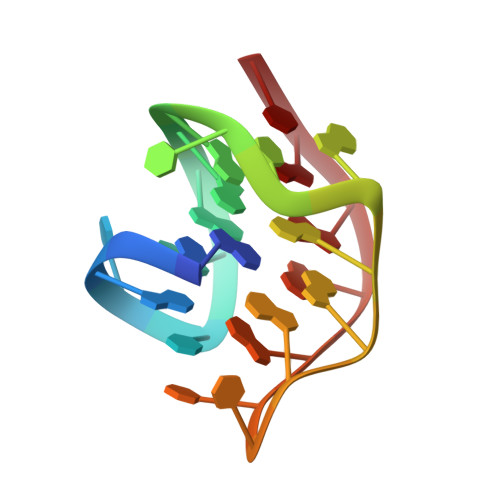Structure of the human telomere in K+ solution: a stable basket-type G-quadruplex with only two G-tetrad layers
Lim, K.W., Amrane, S., Bouaziz, S., Xu, W., Mu, Y., Patel, D.J., Luu, K.N., Phan, A.T.(2009) J Am Chem Soc 131: 4301-4309
- PubMed: 19271707
- DOI: https://doi.org/10.1021/ja807503g
- Primary Citation of Related Structures:
2KF7, 2KF8 - PubMed Abstract:
Previously, it has been reported that human telomeric DNA sequences could adopt in different experimental conditions four different intramolecular G-quadruplexes each involving three G-tetrad layers, namely, Na(+) solution antiparallel-stranded basket form, K(+) crystal parallel-stranded propeller form, K(+) solution (3 + 1) Form 1, and K(+) solution (3 + 1) Form 2. Here we present a new intramolecular G-quadruplex adopted by a four-repeat human telomeric sequence in K(+) solution (Form 3). This structure is a basket-type G-quadruplex with only two G-tetrad layers: loops are successively edgewise, diagonal, and edgewise; glycosidic conformations of guanines are syn x syn x anti x anti around each tetrad. Each strand of the core has both a parallel and an antiparallel adjacent strands; there are one narrow, one wide, and two medium grooves. Despite the presence of only two G-tetrads in the core, this structure is more stable than the three-G-tetrad intramolecular G-quadruplexes previously observed for human telomeric sequences in K(+) solution. Detailed structural elucidation of Form 3 revealed extensive base pairing and stacking in the loops capping both ends of the G-tetrad core, which might explain the high stability of the structure. This novel structure highlights the conformational heterogeneity of human telomeric DNA. It establishes a new folding principle for G-quadruplexes and suggests new loop sequences and structures for targeting in human telomeric DNA.
Organizational Affiliation:
School of Physical and Mathematical Sciences, Nanyang Technological University, Singapore.














